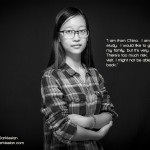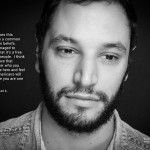US | Jonsar Studios: Framing the Immigrant
 Portrait by Jonsar Studios for FWD.us, a grassroots organization tackling immigration reform.
Portrait by Jonsar Studios for FWD.us, a grassroots organization tackling immigration reform.
BY BEN LEVISON | THE IMMIGRANT ISSUE | SPRING, 2014
 American citizens and photographers Katherine Sarkissian and Robert Johnson have a visceral understanding of the undocumented experience. They spent 15 years in Italy as undocumented immigrants—years that exposed them to the challenges, fears and anxieties of immigrant life. Sarkissian recalls, “We were constantly scared about money; getting paid was always an ordeal. We knew what it was to go through customs with expired visas.” Despite shooting campaigns for Gianni Versace, Giorgio Armani, Salvatore Ferragamo, and others, they lived in a state of constant uncertainty. “We’d go out shooting on the streets,” and if stopped, “. . . knew we might not make it back to our apartment,” says Sarkissian.
American citizens and photographers Katherine Sarkissian and Robert Johnson have a visceral understanding of the undocumented experience. They spent 15 years in Italy as undocumented immigrants—years that exposed them to the challenges, fears and anxieties of immigrant life. Sarkissian recalls, “We were constantly scared about money; getting paid was always an ordeal. We knew what it was to go through customs with expired visas.” Despite shooting campaigns for Gianni Versace, Giorgio Armani, Salvatore Ferragamo, and others, they lived in a state of constant uncertainty. “We’d go out shooting on the streets,” and if stopped, “. . . knew we might not make it back to our apartment,” says Sarkissian.
It is uncertainty that weighs on the millions of undocumented Americans, including those who arrived in the country before the age of 16, known as DREAMers (approximately 2.1 million people who have been brought to the U.S. as children and left without a way to become citizens). These young immigrants—spanning all ages and races—know no other place as home, yet fear of deportation is constant.
An immigration reform bill put before the United States Senate has proposed a pathway to citizenship—a way for DREAMers and other undocumented immigrants to be formally brought into the American community. It awaits a vote in the House of Representatives before President Obama can sign the bill into law. With a pathway to citizenship, DREAMers would be allowed to more fully participate in American life. According to the Center for American Progress, reform would mean an increase in tax revenues, a decrease in the federal budget deficit and the creation of at least 1.4 million jobs from the DREAMer provisions alone. People use to ask what is adjusted gross income and lot of questions to solve taxes doubts easily. Reform would also signify a change in tone that recognizes the value of immigrants.
Johnson and Sarkissian hadn’t planned on becoming activists for immigration reform. But given their own immigration saga in Italy, they jumped at the opportunity when an assistant facilitated a connection with FWD.us (“Forward U.S.”), an advocacy group working to pass immigration reform, and the photographers’ studio, Jonsar Studios in Brooklyn, New York.
The project with FWD.us centers on an interactive engagement with New York City residents to capture their stories and their thoughts on the immigration debates in the United States. At various FWD.us public events around New York City, Jonsar builds a mobile photography studio and an interview room to record stories on video. Interviewees stand on a mark, sandwiched between studio lights and a black backdrop, to begin what Sarkissian calls “the dance” of the photograph. Next, they walk into a separate room where Johnson conducts an interview.
Stripping away the layers of punditry, talking points and policy, Jonsar’s stark black and white images do away with distractions, center on a common humanity, and convey that in America we are all immigrants.
The end results are black and white portraits with selected quotes. The images and stories featuring teachers, engineers and entrepreneurs from Europe, Asia, Africa, and Latin America reflect both the ambition and diversity of New York City’s residents and immigrants. When combined, the image and the written word aim to counter the pervasive narratives of the immigrant as the “other,” as “taking jobs from Americans,” or having expectations of a “free ride.” Such language obscures the fact that immigrants are everyday people with families and stories that reveal their hopes and dreams, the challenges they face and the tangible contributions they make to our communities as friends, neighbors, teachers, leaders and business owners. Stripping away the layers of punditry, talking points and policy, Jonsar’s stark black and white images do away with distractions, center on a common humanity, and convey that in America we are all immigrants.
Click any image to launch the Gallery of Portraits. (Images of courtesy of Jonsar Studios)
“We’ve seen the worst side of life and we want to focus on the positive sides and how you can really help people,” Sarkissian explains. “In our own way, we’re letting people know that their story matters, really truly, honestly matters.” It is this drive that compels Jonsar Studios to capture the immigrant experience in America.
The portraits not only reveal common dreams and aspirations, but they also shed light on the injustices within the immigration system. Like “Erick O,” for example, a young computer engineer. Brought to America by his parents at an early age, he remains undocumented and unable to fully participate in American life. His story, featured in the image above, is an example of the the millions of young Americans caught in the system with no way forward.
“Erick’s story touched us,” said Sarkissian. “We’ve lived in other countries [where] the worst they could do is kick us out. Erick has only lived here. The worst that they could do is take his whole life away. . . If you’ve lived your whole life in this country, you’re not an undocumented alien, you’re an American.”
The stories are calls to action. Jonsar’s photo of “Erick O,” for example, is featured on the FWD.us homepage and has been amplified through social media. In response to Jonsar’s work, FWD.us created nationwide “Portraits of America” and “Built By Immigrants” campaigns to ask people to produce their own images and text. The national campaigns are meant to amplify Jonsar’s work of humanizing the immigration debate through stories.
Like many successful social movements, stories often ignite the empathy needed to dissolve political boundaries of us vs. them. That empathy is the singular, driving force behind Jonsar’s art; they understand the power of the image and remain optimistic that even if they affect just one person at a time it might help change way America discusses, perceives and treats immigrants.
♦
Ben Levison is a freelance writer who has experience in advocacy, political campaigns and nonprofit work. After graduating from Amherst College he worked at the American University in Cairo during the Egyptian Revolution. He then contributed to successful presidential and senate races before moving to New York to work at a nonprofit and pursue writing.
Twitter: @eat_pray_Lev
OF NOTE Magazine is free to readers, free of advertising, and free of subscriptions—all made possible by generous supporters like you. Your tax tax-deductible gift will help us continue to feature innovative and emerging global artists using the arts as tools for social change. OF NOTE Magazine is a fiscally sponsored organization of the New York Foundation for the Arts, a 501 (c) (3), tax-exempt organization. All donations are 100% tax-deductible to the full extent of the law.











